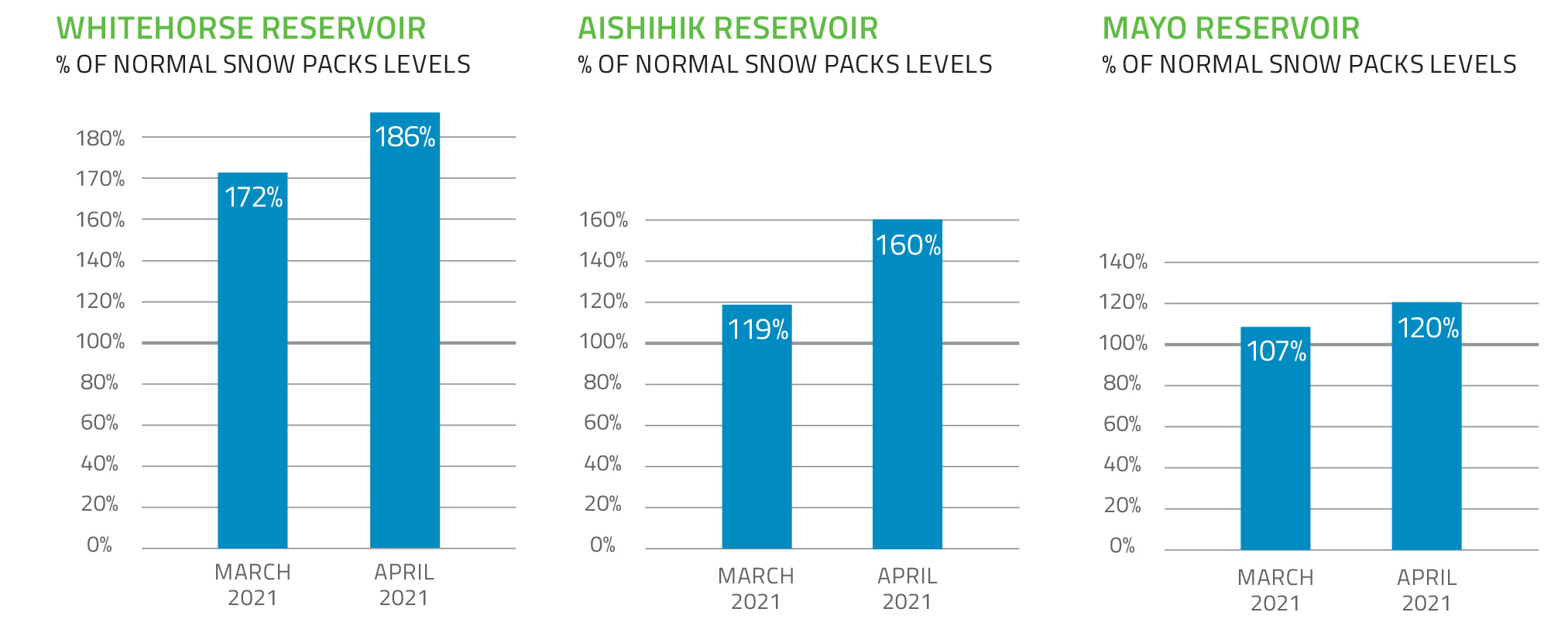April update: Peak water level forecast for Marsh Lake and other hydro basins
News, Energy Supply, Environment
Apr 15, 2021 CommentHYDRO PLAYS A KEY ROLE IN YUKON’S ELECTRICITY MIX.
In 2021, we expect to use water to generate about 94% of the electricity needed by Yukoners connected to the grid.
We own and operate three hydroelectric generation facilities in the territory – one in Whitehorse, one in Mayo and one in Aishihik. Lots of rain last summer and heavy snowfall this winter has resulted in high snowpack levels in each of these areas near our hydro reservoirs.
what high snowpack levels mean for water levels
On their own, snowpack levels don’t paint the full picture of how much water will flow into lakes this year. Three sources of water contribute to reservoir inflows and water levels:
- Snowpack
- Rain
- Glacier melt (for Whitehorse only; not Aishihik or Mayo)
The timing of each of these inflows also plays an important part in determining water levels, as does the natural limits to the amount of water that can flow into a hydro dam (i.e., Miles Canyon).
April 2021 snowpack levels

forecasted summer peak water levels
Marsh Lake – 656.79 m
- Forecast: Above Full Supply.
- Assumes a wet spring.
- Assumes we receive approval from the Yukon Water Board to draw down Marsh Lake 10 cm lower than its permitted Low Supply Level.
- 3 cm lower than the peak water level forecasted in March 2021.
- 55 cm lower than peak water levels during the 2007 flood.
Mayo Lake – 665.84 m
- Forecast: At Full Supply.
Aishihik Lake – 914.82 m
- Forecast: Below Full Supply.
what we have done, and continue to do, to drawn down Marsh Lake
Every spring, we make room in Marsh Lake for rain and spring melt by lowering water levels on the lake close to its Low Supply Level (653.796 m) – the lowest level allowed under our water use licence.
This spring, because of high snowpack levels in the area, we have taken the following steps to increase flows through the Whitehorse dam and to lower levels on Marsh Lake:
- Opened up the gates at the Lewes River Control Structure. All 30 gates have been open since March 19, 2021.
- Lowered water levels on Schwatka Lake by 40 cm.
- Submitted an emergency amendment to our Whitehorse Rapids Generating Station water use licence to the Yukon Water Board on April 1, 2021. The Yukon Water Board is currently deliberating our request.
To date, we’ve had success in lowering water levels on Marsh Lake. Between March 1, 2021 and April 15, 2021, levels on Marsh Lake have dropped 91 cm. Conditions downstream of the Whitehorse dam have also remained typical of this time of year.
Over the next several months, we’ll continue to keep a close eye on lake levels on Marsh Lake and downstream of the dam. As conditions change and our inflow forecasts become clearer, we’ll look at which additional options exist within our control to draw down lake levels even further, if needed. We will always keep the potential effects to the Southern Lakes, to neighbourhoods downstream of the dam, and to the land and environment top of mind.
Comments
Be the first to comment